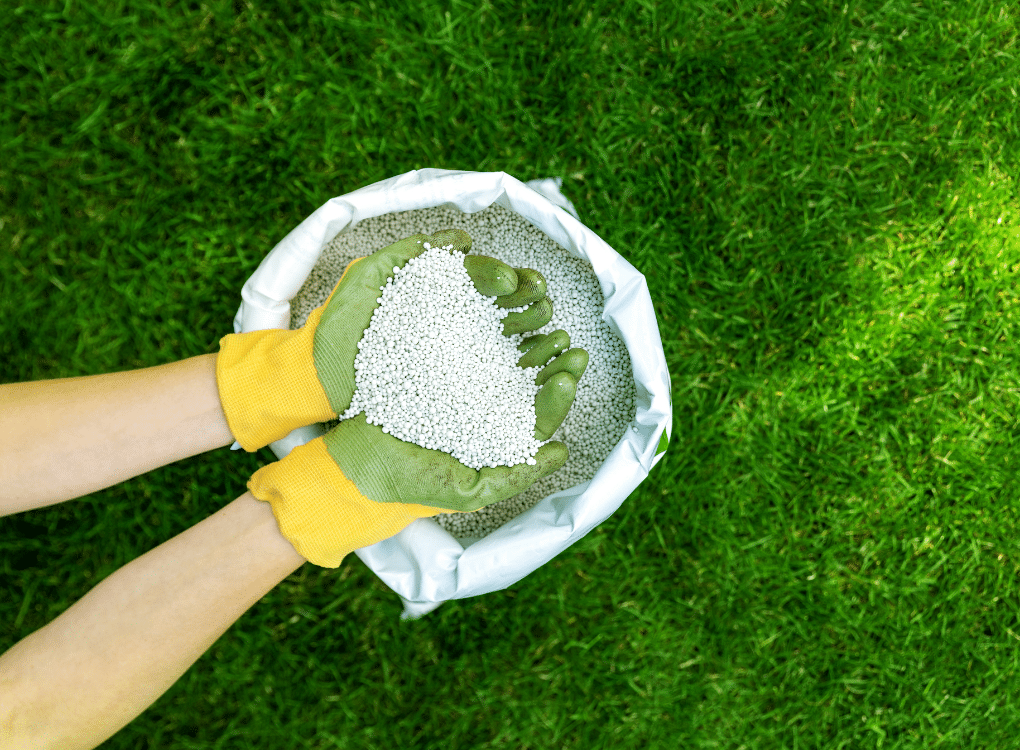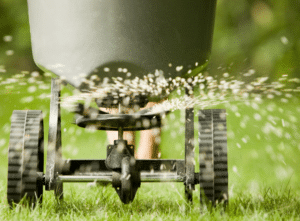A Definitive Guide To Lawn Fertilization

Lawn fertilization plays a crucial role in sustaining a healthy and vibrant lawn. By providing essential nutrients like nitrogen, phosphorus, and potassium, fertilizers promote strong root growth, lush greenery, and overall resilience against pests and diseases. Discover the essential steps and expert tips to achieve a vibrant and healthy lawn with our definitive guide to lawn fertilization.
Regular fertilization replenishes the soil’s nutrients, enhancing its fertility and water retention capacity. A well-fertilized lawn also exhibits improved tolerance to environmental stressors, such as extreme weather conditions. Emphasizing lawn fertilization ensures a lush and attractive landscape, contributing to a welcoming outdoor environment and boosting property value.
Understanding The Basics Of Lawn Fertilization
Lawn fertilization is the practice of applying nutrients to the soil to enhance the growth and health of the grass. It is necessary because fertilizers provide essential elements like nitrogen, phosphorus, and potassium, which support robust root development and lush greenery. Regular fertilization replenishes soil nutrients depleted by grass growth and environmental factors. This ensures a strong and vibrant lawn, resistant to stressors, pests, and diseases, maintaining an appealing outdoor space.
The three key nutrients required for healthy lawn growth are nitrogen, phosphorus, and potassium, commonly represented as N-P-K on fertilizer labels.
- Nitrogen (N): Nitrogen is essential for promoting lush, green foliage and vigorous leaf growth. It aids in the development of chlorophyll, which is crucial for photosynthesis, the process by which plants convert sunlight into energy.
- Phosphorus (P): Phosphorus supports strong root development, seedling establishment, and overall plant growth. It plays a vital role in energy transfer and storage within the plant.
- Potassium (K): Potassium helps improve the overall health and resilience of the lawn. It enhances disease resistance, drought tolerance, and cold hardiness, making the grass better equipped to handle various environmental stressors.

Types Of Lawn Fertilizers
The choice of lawn fertilizer is a personal decision for every homeowner, with various types available at local gardening shops. Fertilizers can be broadly categorized as organic and synthetic options.
Slow-release fertilizers
Recommended for steady and uniform lawn growth, slow-release nitrogen fertilizers provide a consistent supply of essential nutrients to support healthy tuft development. One of their advantages is less frequent application.
Fast-release fertilizers
These fertilizers are quickly absorbed by the grass, promoting rapid greening. Though affordable, they carry a risk of lawn burning and require more frequent application.
Lawn-starter fertilizer
High in phosphorous, this type aids the growth of new grass seeds by reinforcing and strengthening roots.
Weed and feed fertilizer
Serving as both a fertilizer and weed control, this type requires caution with new grass, as some contain herbicides that hinder seed germination.
Winterizer fertilizer
Applied in late fall, it prepares lawns for winter by providing necessary nutrients. The nitrogen content varies for cool-season and warm-season grasses.
The N-P-K Ratio And Its Importance
The N-P-K ratio refers to the three main nutrients found in fertilizers: nitrogen (N), phosphorus (P), and potassium (K). The ratio indicates the relative proportions of these nutrients in the fertilizer product.
For example, a fertilizer with an N-P-K ratio of 10-20-10 means it contains 10% nitrogen, 20% phosphorus, and 10% potassium by weight. The sum of these percentages is usually less than 100 because the remaining percentage represents inert filler materials or micronutrients.
The importance of the N-P-K ratio lies in the specific roles that each nutrient plays in the growth and health of plants:
- Nitrogen (N): Nitrogen is vital for promoting lush green foliage and robust vegetative growth. It is a crucial component of chlorophyll, the pigment responsible for photosynthesis, which is essential for energy production in plants. Adequate nitrogen levels help plants develop strong stems and leaves.
- Phosphorus (P): Phosphorus is essential for promoting strong root development, flower and fruit production, and overall plant growth. It aids in energy transfer and storage within the plant, critical for early root establishment and overall plant vigor.
- Potassium (K): Potassium plays a crucial role in overall plant health and resilience. It enhances disease resistance, improves water uptake efficiency, and helps plants tolerate environmental stresses such as drought, cold, and disease.
The appropriate N-P-K ratio to use depends on the specific needs of the plants and the stage of growth. For example:
- During periods of active growth, a higher nitrogen content (first number) in the N-P-K ratio encourages vigorous vegetative growth.
- For promoting root development, flowering, and fruiting, higher phosphorus (second number) is beneficial.
- Potassium (third number) becomes more important during stressful periods or in preparation for winter, as it helps strengthen plants’ resistance to adverse conditions.
Understanding the N-P-K ratio helps gardeners and lawn care enthusiasts select the right fertilizer for their specific plants, ensuring optimal growth, health, and overall plant performance. It’s essential to follow the manufacturer’s recommendations and consider soil conditions and the stage of plant development when applying fertilizers to achieve the best results.
When To Fertilize Your Lawn
To maintain a healthy and vibrant lawn, it is crucial to fertilize at the right times. At Green’s Lawncare & Property Services, we recommend the following fertilization schedule:
- Early Spring: As the temperatures begin to warm up, apply a balanced fertilizer with a higher nitrogen content to kickstart the lawn’s growth and promote lush greenery. This helps the grass recover from winter dormancy and prepares it for the growing season.
- Late Spring: Around late spring, apply a second round of fertilizer with a balanced N-P-K ratio. This supports continued growth and ensures the lawn remains healthy and green as summer approaches.
- Early Summer: In early summer, consider using a slow-release fertilizer to sustain the lawn’s nutrients throughout the hot months. This helps the grass stay resilient and green even during periods of heat stress.
- Late Summer: Towards the end of summer, apply a fertilizer with a balanced N-P-K ratio to keep the lawn nourished and robust. This prepares the lawn for the upcoming fall season.
- Early Fall: As fall begins, use a fertilizer with a higher phosphorus content to encourage strong root growth and prepare the grass for the approaching winter.
- Late Fall: Finally, apply a winterizing fertilizer in late fall, promoting root development and improving the lawn’s ability to withstand winter’s challenges.
At Green’s Lawncare & Property Services, we know that every lawn is different. That’s why we customize our fertilization schedule to suit your lawn’s unique requirements. Our team of experts is dedicated to delivering excellent lawn care, keeping your lawn healthy, vibrant, and beautiful throughout the year. Trust us to take care of your lawn and make it look its best!

Common Lawn Fertilization Mistakes And How To Avoid Them
During lawn fertilization, several common errors can occur, leading to potential issues with the health and appearance of the lawn. Being aware of these mistakes can help homeowners avoid them and ensure successful fertilization:
- Over-fertilization: Applying too much fertilizer can cause excessive growth, leading to thatch buildup, increased susceptibility to pests and diseases, and environmental pollution due to nutrient runoff.
- Under-fertilization: Insufficient fertilizer application may result in nutrient deficiencies, leading to weak, pale, or slow-growing grass.
- Uneven application: Unevenly distributing fertilizer can cause uneven growth and color variations across the lawn.
- Fertilizing at the wrong time: Applying fertilizer at the wrong time of year or during periods of stress (e.g., drought or extreme heat) can harm the lawn.
- Ignoring soil conditions: Failing to conduct a soil test and adjust the fertilizer based on the lawn’s specific needs can lead to imbalances in nutrients.
- Using the wrong type of fertilizer: Using the incorrect fertilizer formulation (e.g., high nitrogen during winter) can be detrimental to the lawn.
- Applying fertilizer to wet grass: Fertilizing when the grass is wet can result in fertilizer burn and uneven distribution.
- Not watering the fertilizer: Fertilizers should be watered in after application to help the nutrients reach the root zone and prevent burning.
- Fertilizing before heavy rain: Applying fertilizer just before heavy rain can lead to nutrient runoff and waste.
- Failing to read the instructions: Not following the manufacturer’s guidelines and recommended application rates can lead to overuse or underuse of the fertilizer.
Reviving An Unhealthy Lawn
Diagnosing and rectifying lawn problems through fertilization and other appropriate measures require careful observation and understanding of the issues at hand. Here are some guidance steps to help you identify and address common lawn problems:
Diagnosing the problem:
- Observe the lawn closely to identify any visible symptoms, such as discoloration, patches, thinning, or pest activity.
- Conduct a soil test to determine nutrient deficiencies or imbalances, which can affect the lawn’s health and growth.
- Look for signs of pests or diseases, such as chewed grass blades, holes in the lawn, or fungal growth.
Rectifying through fertilization:
- Choose the appropriate fertilizer based on your lawn’s needs and the results of the soil test. Use a fertilizer with the right N-P-K ratio to address specific issues.
- For nutrient deficiencies, apply a balanced fertilizer or one that contains the lacking nutrient. For example, if nitrogen is deficient, use a fertilizer with a higher nitrogen content.
- Use slow-release fertilizers to avoid over-fertilization and ensure a steady nutrient supply over time.
- Follow proper fertilization techniques, including even application and watering the lawn after fertilizing to help the nutrients reach the root zone.
Other appropriate measures:
- For pest issues, consider using natural remedies or targeted pesticides to control the pests without harming beneficial organisms.
- Improve lawn care practices, such as mowing at the right height, watering deeply and infrequently, and removing thatch buildup to encourage a healthier lawn.
- Aerate the lawn to alleviate soil compaction and improve nutrient absorption by the roots.
- Address any drainage problems to prevent waterlogged or dry spots on the lawn.
Maintaining A Fertilization Schedule and Recordkeeping
Regular fertilization and maintaining a consistent schedule are essential aspects of effective lawn care, contributing significantly to the health and beauty of your lawn. Fertilization provides vital nutrients that support robust root development, lush foliage, and overall plant strength.
The consistent supply of nutrients ensures that the grass has what it needs to thrive, making it more resilient to environmental stressors, pests, and diseases. By following a consistent fertilization schedule, you promote balanced growth, avoiding sudden surges of nutrients that may lead to excessive growth or lawn burn. This steady approach encourages a sustainable and attractive lawn throughout the growing season.
Maintaining a regular fertilization schedule prevents nutrient deficiencies or imbalances, which can cause various issues like pale and weak grass, poor root development, or increased susceptibility to diseases. A well-fed lawn is better equipped to withstand drought, extreme temperatures, and other challenging conditions.
A consistently nourished lawn tends to develop a denser and healthier turf, which helps suppress weed growth, reducing the need for herbicides. Ultimately, the importance of regular fertilization lies in its ability to provide the necessary elements for your lawn’s sustained health and appearance, making it a vital component of successful lawn care practices.
To Sum It Up
Looking to transform your lawn into a lush and vibrant masterpiece? Choose Green’s Lawncare & Property Services for a lawn that stands out in the neighborhood, impressing friends and family alike. Our dedicated team is committed to providing top-notch lawn care, and we take pride in helping you achieve the lawn of your dreams.
Don’t wait any longer – experience the difference with Green’s Lawncare & Property Services and witness the transformation of your lawn into a breathtaking oasis. Contact us today and let us bring your lawn to life!